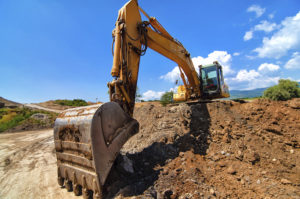
When it comes to construction, a solid foundation is everything. If you have ever wondered how construction crews create a compact base for their projects, this blog will shed some light on the subject. There are many different materials that contractors can use to create stable foundations, even out the terrain, and fill holes at the worksite. All of these materials must be applied correctly and compressed to build a strong foundation. Materials like sand, dirt, and rock that can be used to create these compact foundations are called “compactable fill.” In this week’s blog, we will discuss three different types of compactable fill that are used in construction today.
Fill Dirt
The term “fill dirt” can describe many different types of dirt. Topsoil, subsoil, gravel, sand, and clay can all make up compactable fill in varying amounts to produce a product that is still considered “fill dirt.” The type of fill dirt used depends heavily on the project and its requirements. For example, creating the foundation for a building would likely require clean fill dirt that is high in clay, while leveling out a dip in a golf course would require the use of topsoil. This is because the first project would need a highly-compressed clean soil, and the second project would require soil that is rich in nutrients to support grass. Composition is critical in grading and compaction, and project engineers will detail the specifics of what is needed from the compactable fill.
Rock Fill
Rock fill is used to even out or fill larger holes. It is usually made up of large rocks harvested from excavation sites, and it is useful for many large-scale projects. For developments that use rock fill, an added layer of topsoil must be placed on top of the rock fill for any landscaping endeavors. This layer of topsoil is often quite thick, and the soil may need amendments in the form of mulch or compost.
Fill Sand
Fill sand takes many forms, but all are often used to fill areas that are low in elevation. Individual grains of sand can be sharp or rounded, regular or irregular. These physical qualities that the sand exhibits on a small scale can have large-scale consequences in terms of its ability to be compacted. Because sand is made up of crushed rock and does not compress or absorb water in the same way that dirt does, it is often used to improve a site’s drainage. This is a popular fill material around ponds, septic tanks, and other damp areas.
ABOUT RELIABLE CONTRACTING
Reliable is dedicated to delivering quality products, displaying professionalism within the firm, seeking new opportunities for expansion and profitability, and providing an environment for individual success. If you have a commercial or residential construction project that you need taken care of, please contact Anne Arundel County’s largest site-work contractor today by calling 410-987-0313 or visiting our website. You can also follow Reliable Contracting on Facebook, LinkedIn, Pinterest, and Twitter!
Reliable Contracting Company serves the following and surrounding counties: Annapolis, Queen Anne’s, Anne Arundel, Baltimore, Baltimore City, Calvert, Caroline, Charles, Howard, Prince George, St. Mary’s, Talbot, and Washington D.C.
